More than 9,000 years ago, humans discovered how to manufacture wine, Vietnamese people have also known how to cook from King Hung's reign (about 2 thousand years ago, according to the book Linh Nam Trich Quai). Until recently, describing traditional Vietnamese wine impliedly refers to the country's two distinct wine yeast strains, Leaf yeast and Chinese medical yeast (Chinese yeast).
If the Kinh people, who make up 85% of the population, use Chinese medical yeast extensively in the delta, leaf yeast produces one-of-a-kind wine products that are infused with ethnic minority culture.
Cultural interference is becoming increasingly widespread as a result of trade. As a result, leaf yeast wine is becoming increasingly popular across the country. People increasingly choose leaf yeast wine due to their preference for light wine with a distinct flavor, as well as the uniqueness of the manufacturing method or the story behind the leaf yeast.
Today, as part of a series of articles about leaf yeast wine, let's journey with Viet Wine to several regions to learn how indigenous people make yeast cakes that are distinctive to their people and regions.
What is leaf yeast? There is no official definition, but it is a common word for "wine yeast cake" made with traditional Vietnamese herbs and spices from ethnic minority groups. Each region and ethnic minority has its own specific yeast, which is determined by the culinary culture of each ethnic group as well as the medicinal plants and spices present in each location.
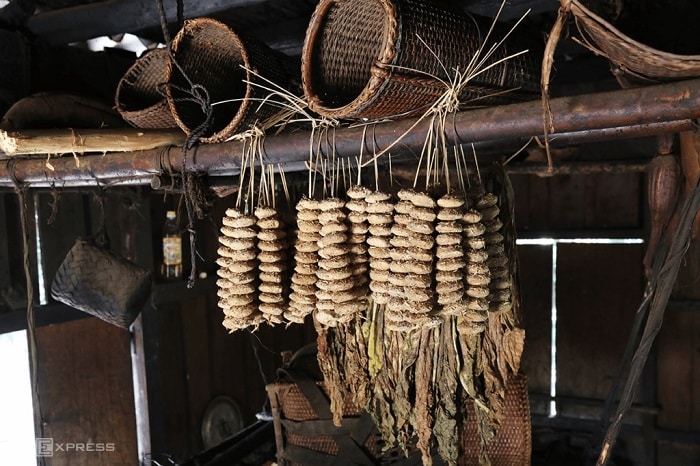
1. Lang Son leaf yeast
Lang Son is a province whose ethnic minorities make for 84% of the population, with the Nung ethnic group accounting for 43%, Tay 36%, Dao 4%, San Chay... Lang Son yeast consists primarily of Wedelia, Co xay , Co slam, Slic lac….
Going higher up Mau Son, the Red Dao people say there are five different varieties of the remedy, but they all involve the 36-root tree (Pi_na_ma), Tang_Kha_mé tree, Pi_na_thon tree, Hoa Vang, Pu cai leaves, piper Chaudocanum C. DC, Stevia rebaudiana... Mau Son leaf yeast is the soul, the essence that makes "Mau Son wine" famous.
Among the well-known leaf yeast locations in Lang Son are Mau Son (located in the Loc Binh district) and Binh La (a commune in the Binh Giang district).
Known wine names in this area are Mau Son Alcohol, Cong Son Alcohol, Bac Son Alcohol, and so on. Rượu Bắc Sơn, Rượu Mẫu Sơn, Rượu Công Sơn…
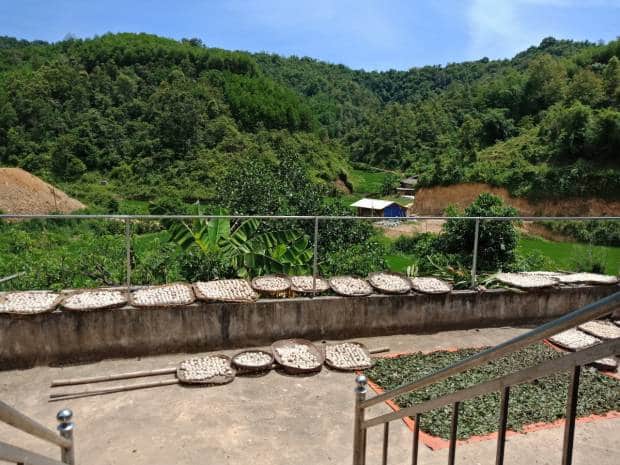
2. Tuyen Quang leaf yeast
Highlighting Tuyen Quang means highlighting the specialty dried buffalo meat, dried bamboo shoots, and Corn leaf alcohol, a necessary wine passed down through thousands of years.
Tuyen Quang is likewise a northern highland province with 57% ethnic minorities, the most of whom being Tay, San Chay, Dao, Pa Then, Lo Cao...
In the province, the Tay represent the largest ethnic minority. Here, they are the proprietors of the well-known yeast-leaved cakes and corn wine. Introduction and custom state that 20–30 different kinds of herbs, including Gieng Do, Can Cuong, Keng Noc Khoa, Khuc Khac, Khau Pùng, Nhan Tran, Cam Thảo Nam, Son Thuc, and Ma De, are utilized in the manufacturing of wine yeast.
Furthermore, there are numerous leaf remedies that make use of plants like Khau Vi, Rhizoma Heterosmilacis, wild chilli, Nuom bananas, Lac Deo, Thau Tai Bau, Mia Gio, Tham Chang, Dua Poong, Nau Ao, Phet Dong, Sam Bua, No Nghieu, Lac pai Dong tree, Nha Heo, Tang To, Thach Xuong Bo, Sa Nhan, Zingiber, crust and roots of Can Cuong tree, jackfruit leaves, Net Ty Po, Lac Dam, Piper betle L, Nha Dong, Mat Vai,…
Na Hang Leaves Yeast from Na Hang District is well-known in Tuyen Quang. It is home to numerous distilleries and businesses that make yeast cakes. Medicinal plants undergo changes throughout time, but they all provide a distinct wine flavor that is distinct from wine produced by other ethnic groups or areas. Men Lá Na Hang (huyện NaHang). Ở đó có rất nhiều lò rượu và cơ sở làm bánh men, dù có sự vi chỉnh các cây thuốc theo thời gian, nhưng đều cho một mùi vị rượu đặc trưng, khác hẳn rượu các dân tộc hay vùng miền khác.
Famous names that are frequently referenced are Ngo Na Hang Wine and Tuyen Quang Ngo Wine... Rượu Ngô Na Hang, Rượu Ngô Tuyên Quang ….
3. Cao Bang leaf yeast
Few people know that Cao Bang province, in addition to 7-flavor Roasted Duck, Coong Phu Cake, or steamed rolled rice pancakes, has a famous corn wine with a light concentration, sweet and aromatic aftertaste, smooth and attracting visitors.
In Cao Bang, ethnic minorities account for 95%, of which Tay 40.83%, Nung 29.81%, Mong 11.65%, Dao 10.36%, San Chi 1.49%, Lo Lo 0, 54%…
The Tay people, like Tuyen Quang, are the province's largest ethnic group, therefore the leaf yeast cake has herbs and spices comparable to the Tay people in other provinces, and Ngo Men La wine is also a Cao Bang specialty.
Winery owners are distributed throughout the province's towns and hamlets, although there are several villages that have been brewing wine for a long time and still have many distilleries, such as Thong Nong, Ban Vieng, Coc Ca, Na Rang... Thông Nông, Bản Viềng, Cốc Ca, Nà Rằng …
Many people are familiar with wine labels, like Na Rang Leaf Yeast Wine and Thong Nong Leaf Yeast Wine.
4. Ha Giang leaf yeast
When we talk about the province of Ha Giang, we think of the Meo King, the terraced fields of Hoang Su Phi, or the well-known Thang Co meal, which is accompanied with wine made from Ha Giang leaves.
Ha Giang, a province with 84% of the population are ethnic minorities including H'Mong 32.9%, Tay 23.2%, Dao 14.9%, Nung 9.7%...
As the province's main ethnic group, Ha Giang leaf-fermented corn wine is steeped in the tradition of the H'Mong and Tay people who live on the Dong Van stone plateau in four districts: Quan Ba, Yen Minh, Dong Van, and Meo Vac.
Typical herbal medicines here are lemongrass, jackfruit leaves, Nha Heo, Vat Veo, Vietnamese Coriander, Piper Betle, Cha Pao, Lac Toc, Leng Noc Kieu, Adenosma caerulea R.BR. , Lac Kha, Chi Ot, Tham Chang, Tham Ngam, Can Cuong, chilly leaves, …
Leaf yeast cake may be found in Xuan Giang commune, Quang Binh district, where it has been passed down through many generations. If you wish to drink wine, head to Quan Ba and try the famed wine of this region.
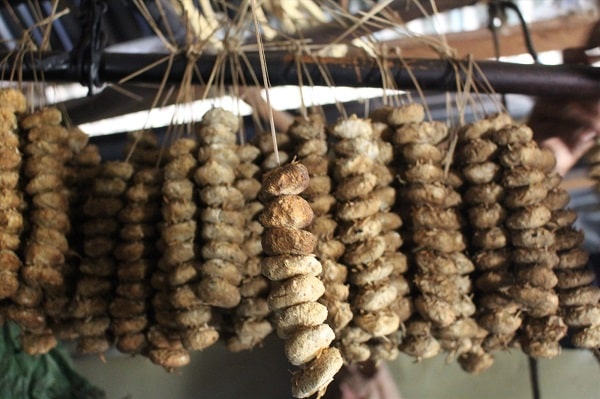
5. Bac Giang leaf yeast
When we think of Bac Giang, we think of Luc Ngan lychees, or Chu dry rice wafer, and just a few wine lovers are aware that this location also produces legendary leaf yeast wine, which is distributed to all regions.
Although ethnic minorities make up 14.7% of the Bac Giang population, despite the province's high overall population (1.8 million people), the number of ethnic minorities is comparable to Lang Son and Ha Giang. …
With 96 thousand individuals, the Nung are the province's largest ethnic group, with the majority living in Luc Ngan district.
With the aforementioned ethnic features, the yeast leaves of Bac Giang province are the yeast leaves of the 2-3 most populous ethnic communities. Specifically, leaf medicinal herbs of the Tay ethnic group are grown in Son Dong district, or Nung leaf yeast from the Luc Ngan district. Ingredients that are frequently mentioned here include: hundred- root tree, Gioi Gioi leaves, Sida rhombifolia, Tai Cho leaves, Vat Huong, …
Many communes and villages produce well-known wine, which is then distributed throughout the country. The alcohol of Kien Thanh commune, Luc Ngan district of the Nung ethnic group is well-known in the province.
6. Men lá Bắc Kạn
When mentioning Bac Can province, we think of Ba Be fermented pork rolls, Melientha Suavis Pierre, or the locations of Ba Be Lake, Don Market, etc. No one forgets to mention the Na Ri, Bang Phuc, leaf yeast wine...
In the province, minorities make up 88% of the population. Nung (9.15%), Mong (7.2%), Dao (17.86%), and Tay (52.58%) make up the majority.
Numerous variations of leaf yeast medication exist due to the coexistence of 22 ethnic groups; however, the Tay people, who make up the majority ethnic minority in the province, are the source of the leaf yeast known as Cao Bang leaf yeast.
Although the Tay ethnic group in Cao Bang uses the same medicinal herbs as those in nearby provinces, they also use other plants and spices, including amomum, Clinacanthus nutans, Mau Than, and Mimosa pudica.
The villages and hamlets in Cho Don and Na Ri districts, the most well-known of which is Bang Phuc commune, are noted for their large number of households that produce wine and yeast cakes. nổi tiếng nhờ có những làng, bản tập trung nhiều gia đình sản xuất rượu và làm baáh men, nhiều nhất và nổi tiếng nhất là xã Bằng Phúc
7. Lao Cai leaf yeast
When we hear the name Lao Cai province, we instantly think of the well-known tourist attraction Sapa, with specialties including rice cooked in bamboo tubes, hand-carried piglets, Thang Co meal, and, of course, the region's well-known wine, San Lung Alcohol. Rượu San Lùng
In the northern border province of Lao Cai, ethnic minorities make up 66% of the population. With 28 ethnic groups coexisting, the H Mong people account for 23.8% of the population, followed by the Dao people (14.4%),… It is also the province with the country's second largest Dao population.
Liquor is made by ethnic minorities distributed throughout the villages. However, San Lung hamlet is the most well-known in the province because, while there are only 40–50 households, up to 70% of them manufacture wine or yeast, which is how the San Lung wine brand (Ban Xeo commune, Bat Xat district) came to be well-known throughout the country. A specialty wine of the Dao people made from grain (not from rice, corn... as usual).
The alcohol yeast used in this region is created from 15-25 leaves and indigenous spices. Ban Pho and Bac Ha corn wine are also popular in the province; it is unique since it is prepared with Hong Mi yeast.
The seeds of the natural grass Hong Mi are collected between September and October and kept in the kitchen for year-round use. The secret to this region's wine's distinctive flavor is reportedly found in tiny, enigmatic black Hong Mi seeds.
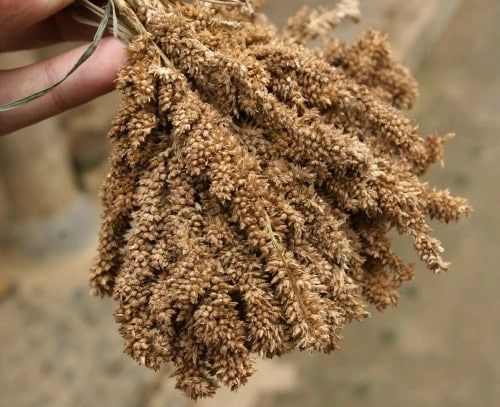
8. Nghe An leaf yeast
We instantly think of Nghe An when discussing its specialties, which include eel congee and veel sausages (produced from young calf or buffalo meat)….Con Cuong La Men wine is one type of wine that wine connoisseurs instantly recall. It appeared to be lost but has now been resurrected because of local wine enthusiasts. Men lá Con Cuông.
Nghe An is the fourth most populous province in the country, with just 15% ethnic minorities, the Thai ethnic group being the largest with 340,000 people (also the province with the second greatest Thai population in the country). In this province, the Tay people make up only one-fifth of the total population of Thais, while other ethnic minorities are smaller.
That's why Nghe An's typical leaf yeast wine is the wine of the Thai people, also known as "lau xieu xa".
This alcohol's leaf yeast is derived from ten to twenty distinct plants and herbs, including common garden plants like jackfruit, cinnamon, sugarcane, mu tun as well as uncommon leaves like Vang Gua, Adenosma caerulea R.Br., and Kha Na that are harvested from the forest.
According to legend, this well-known wine was previously served to upper class people, including monarchs and mandarins. So being able to appreciate the specialties of this region once is a lucky and intriguing thing that wine connoisseurs should not miss.
9. Quang Tri leaf yeast
Quang Tri is the province with the fewest people in the North Central area. The Kinh people are the majority here, with only two ethnic minorities accounting for 9% of the province's population: the Van Kieu and the Pa Co.
The Van Kieu and Pa Co people have continued the long-standing custom of producing leaf yeast wine, or Van Kieu leaf yeast for short. According to legend, this wine is made from nine different kinds of forest tree roots, fruits, stems, barks, and more that the Pa Co people must search for deep within the forest. These include Ngheng leaves, Cu rai leaves, wild chilli, and the roots of Pa Nang trees, Bua tree, wild peppers.
People here say that rice cultivated in the highlands must be combined with 10–20 different varieties of forest tree leaves and roots to make exquisite yeast cakes. The two most significant leaf types, xa_á_ta_moi and ra_pét_a_lo, are what distinguish the yeast in this case in terms of quality and distinctiveness. In addition to the leaves, the glutinous red sticky rice flour—a unique variety of rice from Da Ban village—that is used as the yeast cake's growing medium makes this region's yeast cake unique.
According to the Pa Co people's experience, the best quality leaf yeast is when you break a little piece and place it in the charcoal burner, the yeast will ignite and have a blue flame. Da Ban leaf yeast can be utilized very well the next year if stored properly in a dry place.
Such a feat, but due to problems in yeast bread production and low alcohol production efficiency, this leaf yeast wine is becoming increasingly rare. The most significant impediment is the inefficiency of alcohol production, which makes it impossible to compete with today's commercial and enhanced yeast strains. So, if you have the chance to visit Huong Hoa, Quang Tri, one thing you should not miss is to experience the specialty wine of this location with the soft Terate'k melody, so you don't regret it later. to gain a deeper understanding of the local culture.
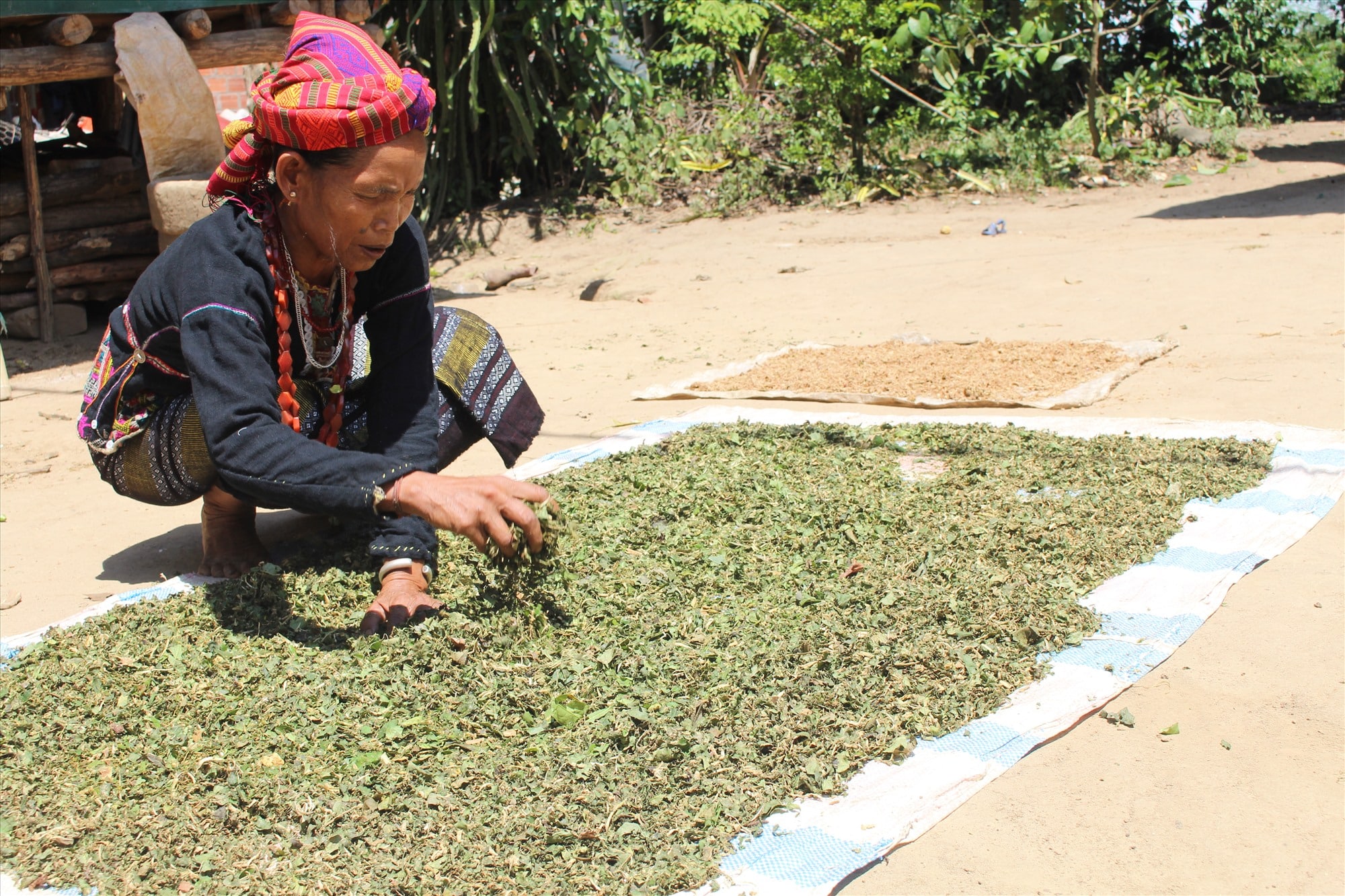
10. Tay Nguyen leaf yeast
Tây Nguyên là vùng đất cao nguyên Nam Trung Bộ gồm 5 tỉnh Kon Tum, Gia Lai, Đắk Lắk, Đắk Nông, Lâm Đồng. Các dân tộc thiểu số nơi đây chiếm 37% dân số, trong đó người Gia Rai đông nhất với 44 vạn chiếm 8% dân số, kế đến là người E Đê 33 vạn chiếm 6%, người Ba Na 23 vạn chiếm 4,3% …
As we approach the Central Highlands, a region known for its red soil and coffee, we couldn't help but highlight its undistilled Can wine, which is a hallmark of the area.
A variety of herbal formulations are frequently used to make can wine. The Brau ethnic group, for instance, uses ten popular plant varieties with various flavors: sweet (Da Bo La tree, Dung Dung tree, and Tac To Rac tree stems); In addition to the bark of the Dac tree, Po Em tree, Nang Van, Ca Xom, and occasionally sugarcane (Ka Dao tree), bitter flavor (Ho Vac, Cho Ia Ang).
The E De people make a delectable Can wine with distinct bitter, spicy, sour, and sweet characteristics using the Oka Ngam tree (sweet tree), red galangal, and Hedychium gardnerianum.
Tay Nguyen Can wine's flavor and qualities vary greatly because each ethnic group has its own unique recipe. If you've tried a variety of wines, you'll notice that each ethnic group has its own distinct flavor: E De wine (wine with various sour-spicy-bitter-sweet characteristics), M' Nong wine (golden color), Muong wine (sweet and aromatic taste). Conclusion
In conclusion
Rượu men lá là một đặc sản của đồng bào dân tộc thiểu số nước ta.
Với 54 dân tộc anh em, và không phải dân tộc nào cũng có bài men rượu cho riêng mình, nhưng “chuyến du lịch” trên cũng cho ta thấy sự đa dạng của Rượu và Bánh men lá về cả nguyên liệu lẫn kĩ thuật sản xuất.
This diversity stems from each ethnic group's culinary culture as well as the types of plants found in each region's soil.
That diversity results in a variety of flavors in each type of wine, not just one sort of leaf yeast wine, as many people wrongly believe.
Leaf yeast wine has been and continues to contribute to the uniqueness and richness of Vietnamese traditional wine. It reflects culinary culture, history, and ethnic qualities that every Vietnamese people should experience and explore at least once in their lives.
